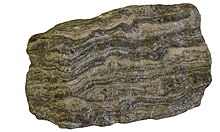Foliation (geology)


Foliationin geology refers to repetitive layering inmetamorphic rocks.[1]Each layer can be as thin as a sheet of paper, or over a meter in thickness.[1]The word comes from the Latinfolium,meaning "leaf", and refers to the sheet-like planar structure.[1]It is caused byshearing forces(pressures pushing different sections of the rock in different directions), ordifferential pressure(higher pressure from one direction than in others). The layers form parallel to the direction of the shear, or perpendicular to the direction of higher pressure. Nonfoliatedmetamorphic rocksare typically formed in the absence of significant differential pressure or shear.[1]Foliation is common in rocks affected by the regionalmetamorphiccompression typical of areas of mountain belt formation (orogenic belts).
More technically, foliation is any penetrative planarfabricpresent in metamorphic rocks. Rocks exhibiting foliation include the standard sequence formed by theprograde metamorphismofmudrocks;slate,phyllite,schistandgneiss.Theslateycleavagetypical of slate is due to the preferred orientation of microscopicphyllosilicatecrystals.In gneiss, the foliation is more typically represented by compositional banding due to segregation of mineral phases. Foliated rock is also known asS-tectoniteinshearedrock masses.
Examples include the bands ingneiss(gneissic banding), a preferred orientation of planarlargemica flakes inschist(schistosity), the preferred orientation ofsmallmica flakes inphyllite(with its planes having a silky sheen, calledphylitic luster– the Greek word,phyllon,also means "leaf" ), the extremely fine grained preferred orientation of clay flakes inslate(called "slaty cleavage"), and the layers of flattened, smeared, pancake-likeclastsinmetaconglomerate.[1]
Formation mechanisms[edit]
Foliation is usually formed by the preferred orientation ofmineralswithin a rock.
Usually, this is the result of some physical force and its effect on the growth of minerals. The planar fabric of a foliation typically forms atright anglesto the maximum principal stress direction. Insheared zones,however, planar fabric within a rock may not be directly perpendicular to the principal stress direction due to rotation, mass transport, and shortening.
Foliation may be formed by realignment ofmicasandclaysvia physical rotation of the minerals within the rock. Often this foliation is associated withdiageneticmetamorphism and low-grade burial metamorphism. Foliation may parallel original sedimentary bedding, but more often is oriented at some angle to it.
The growth of platy minerals, typically of the mica group, is usually a result ofprograde metamorphicreactions during deformation. Often,retrograde metamorphismwill not form a foliation because the unroofing of a metamorphic belt is not accompanied by significant compressive stress. Thermal metamorphism in theaureoleof agraniteis also unlikely to result in the growth of mica in a foliation, although the growth of new minerals may overprint existing foliation(s).
Alignment of tabular minerals inmetamorphic rocks,igneous rocksandintrusive rocksmay form a foliation. Typical examples of metamorphic rocks includeporphyroblasticschists where large, oblate minerals form an alignment either due to growth or rotation in the groundmass.
Igneous rocks can become foliated by alignment ofcumulate crystalsduringconvectionin largemagma chambers,especiallyultramaficintrusions, and typicallyplagioclaselaths.Granite may form foliation due to frictional drag onviscousmagma by the wall rocks. Lavas may preserve a flow foliation, or even compressedeutaxitictexture, typically in highly viscousfelsicagglomerate,welded tuffandpyroclasticsurge deposits.
Metamorphic differentiation, typical ofgneisses,is caused by chemical and compositional banding within the metamorphic rock mass. Usually, this represents theprotolithchemistry, which forms distinct mineral assemblages. However, compositional banding can be the result ofnucleationprocesses which cause chemical and mineralogical differentiation into bands. This typically follows the same principle as mica growth, perpendicular to the principal stress. Metamorphic differentiation can be present at angles to protolith compositional banding.
Crenulationcleavageandoblique foliationare particular types of foliation.
Interpretation[edit]
Foliation, as it forms generally perpendicular to the direction of principal stress, records the direction of shortening. This is related to the axis of folds, which generally form anaxial-planarfoliation within their axial regions.
Measurement of the intersection between a fold's axial plane and a surface on the fold will provide thefold plunge.If a foliation does not match the observed plunge of a fold, it is likely associated with a different deformation event.
Foliation in areas of shearing, and within the plane ofthrust faults,can provide information on the transport direction or sense of movement on the thrust or shear. Generally, the acute intersection angle shows the direction of transport. Foliations typically bend or curve into a shear, which provides the same information, if it is of a scale which can be observed.
Foliations, in a regional sense, will tend to curve around rigid, incompressible bodies such as granite. Thus, they are not always 'planar' in the strictest sense and may violate the rule of being perpendicular to the regional stress field, due to local influences. This is a megascopic version of what may occur around porphyroblasts. Often, fine observation of foliations on outcrop, hand specimen and on the microscopic scale complements observations on a map or regional scale.
Description[edit]
When describing a foliation it is useful to note
- the mineralogy of the folia; this can provide information on the conditions of formation
- the mineralogy in intrafolial areas
- foliation spacing
- anyporphyroblastsor minerals associated with the foliation and whether they overprint it or are cut by it
- whether it is planar, undulose, vague or well developed
- its orientation in space, as strike and dip, or dip and dip direction
- its relationship to other foliations, to bedding and any folding
- measureintersection lineations
Following such a methodology allows eventual correlations in style, metamorphic grade, and intensity throughout a region, relationship tofaults,shears,structures and mineral assemblages.
Engineering considerations[edit]
Ingeotechnical engineeringa foliation plane may form adiscontinuitythat may have a large influence on the mechanical behavior (strength, deformation, etc.) of rock masses in, for example,tunnel,foundation,orslopeconstruction.
See also[edit]
References[edit]
- Blatt, Harvey and Tracy, Robert J.; 1996,Petrology: Igneous, Sedimentary, and Metamorphic,2nd ed., p. 359-360, W. H. Freeman,ISBN0-7167-2438-3
- Vernon, Ron H., 2004,A Practical Guide to Rock Microstructure,Oxford University Press, Oxford.ISBN0-521-89133-7

